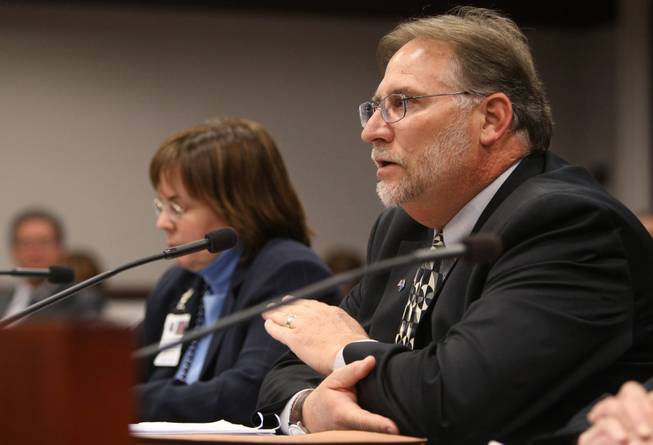
AP Photo/Nevada Appeal, Cathleen Allison
State human services director Mike Willden talks during a 2009 meeting.
Friday, Jan. 18, 2013 | 2 a.m.
The services the state provides to the poor and disabled, including for autistic children and allow the physically and mentally disabled to remain in their homes, would make “significant progress” under Gov. Brian Sandoval’s budget, the director of the state’s Department of Health and Human Services said.
But Nevada’s safety net for the most vulnerable still will have waiting lists of hundreds of children and adults with needs. And the state will not increase the rates — which haven’t been changed since 2007 — it pays hospitals and many doctors to care for Medicaid patients, raising concerns about how an estimated 150,000 new patients will receive care.
This week, Sandoval presented a mostly status quo budget for the next two years, with some targeted increases in funding for specific programs for schools, higher education, and health and human services.
Sandoval’s overall budget for health and human services for the next two years is $7.4 billion, an $800 million increase over the current budget. Most of that money will come from the federal government.
But Sandoval did direct about $163 million in state money to programs that had garnered media coverage because of cuts to services since 2011.
“We’re making progress in a number of areas,” Department of Health and Human Services Director Mike Willden said Thursday. “I think the governor has been more than fair to HHS.”
• In early intervention services, which serves newborns to 3-year-old children with disabilities, Sandoval increased funding by $11 million to handle caseload increases and eliminate waiting lists, Willden said.
The program, which served 2,800 children last June, is expected to grow to 3,200 children in 2014 and 3,600 children in 2015.
• A state autism program, which currently is full and has more than 400 children waiting for services, is budgeted to grow from 137 clients this year to 236 clients next year and 341 clients in the 2015 budget year.
But the funding does not completely eliminate the waiting list.
“I’m very happy he’s adding more money to the autism budget, which means we’ll be able to serve more kids,” said Jan Crandy, an advocate for those with autism.
But she said she’d seek more money from the Legislature, which begins meeting in February.
“I’m greedy for our kids with autism,” she said.
Willden said eliminating the autism list altogether came down to the same old barrier.
“It’s always a money issue,” he said.
• The state’s programs to help those with mental or physical disabilities stay in their houses and out of nursing homes also will grow significantly. Willden said that some of the waiting lists, which can be up to a year and a half, still will be lengthy.
Jon Sasser, an advocate for social services, said the budget is “way better than it was two years ago.”
He said the biggest driver in the overall improvement is Sandoval’s decision to expand Medicaid, the health insurance for the poor, which will decrease the number of uninsured Nevadans. Nevada has one of the highest uninsured rates in the nation and has the highest rate of uninsured children.
But rates the state pays to hospitals and many doctors who care for Medicaid patients have been frozen since 2007, prompting concerns doctors will turn newly insured patients away.
“Even though they’ve got a Medicaid card, they have to find a provider who’ll take it,” Sasser said. “The rates the state pays is inadequate to meet their cost.”
Willden said that because the agency knew money would be tight, they did not bother to pencil out the costs of increasing rates for hospitals and specialists.
Primary care doctors will see an increase in pay under the Affordable Care Act. Sandoval also agreed to use state dollars to extend the higher payment for primary care doctors for the first six months of 2015, when the federal payments run out.
Sasser applauded some of the targeted increases, including those for early intervention programs and autism.
But he said that funding for state programs, which was barebones even at the start of the recession, haven’t been fully restored. Mental health, for example, has been reduced by $80 million since 2007.
Willden said Sandoval did add some money to the mental health budget, including funding a walk-in clinic in Las Vegas that will be open 24 hours a day, at a cost of about $800,000. But, he acknowledged, that with the increased attention nationally on mental health, it would be one area to look if there’s more money available.
Sasser said there are still great needs in the state.
“Anybody who believes we’ve gone back and undone the harm done since 2007, or we’re going to get off the bottom of any of the bad lists, is naive,” he said. “We’ve taken nice small steps forward.”

Join the Discussion:
Check this out for a full explanation of our conversion to the LiveFyre commenting system and instructions on how to sign up for an account.
Full comments policy